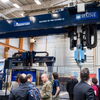Metal is taking more of the roofing market as competition grows
Three years ago, Everlast Roofing of Bridgton heard a competitor was about to buy a machine that would allow it to cut and shape sheet metal for roofs. So it took a leap and beat them to it. Everlast bought a $600,000 roll former, a 160-foot-long conveyer-and-piston contraption that crimps interlocking ribs into 3-foot-wide sheets of roofing metal. Back then, Everlast's granddaddy roll former was the only one in Maine, and the edge it gave the company was significant. Overnight, Everlast could provide custom-cut metal to Maine retailers faster than competitors relying on out-of-state manufacturers. Sales went up and Everlast became the contender of note.
Then, everybody bought themselves roll formers.
Today, four other manufacturers in Maine have roll formers as large as Everlast's to make seamless metal roofing, and dozens of others have invested in smaller, portable, more affordable roll formers that cut ribbed metal panels that snap together in what are called "standing seam" roofs. Roll formers are an investment of $15,000 to $600,000, depending on their size, capacity and durability. In the growing metal roofing market, most roofers say being able to custom cut panels is worth the investment.
"It's more and more about the competition and the equipment now," Everlast's northeast manager, Lee Eastman, says in his office in a steel warehouse near Bridgton's downtown, his chocolate Lab Nate nosing at the office employees who slip in and out putting folders into a tall file cabinet set against one wall. "If they get as good as we are, then it makes it harder for us. But I always look at it from the standpoint of, 'You don't want to set the bar, you want to be the bar.'"
A matter-of-fact redhead with a tendency to, as he puts it, "grab hold of knowledge," Eastman is president of the Bridgton Economic Development Corp., in addition to running the northeast division of the Pennsylvania-based metal materials manufacturer Everlast Roofing Inc., which recorded revenues in the range of $65 million last year.
Eastman has been in the roofing business for 17 years. He started out in lumber, where he thought he'd stay for his whole career, but on the sales floor at Hancock Lumber, Eastman was approached by customers who were curious about metal roofing. No one on the team, including Eastman, knew much about metal. So Eastman started calling around, asking contractors about the material and visiting job sites to learn about its installation. Soon, he says, he became the go-to metal man at Hancock. That was in the late 1980s. By 1998, Craig Covell, president of Everlast, had recruited Eastman to join the company's metal sales department.
"I never planned to get into metal, but I love it now," Eastman says. Behind him hangs a corkboard covered with color print-outs of photos of his baby granddaughter, his adult daughters and the racehorse that his family sponsors annually at the Fryeburg Fair. "The market is ever-changing. If you can't turn on a dime you're going to get eaten alive. That's almost any business."
Metal roofing, made up largely of 3-foot-wide steel panels, has lately gained ground in a domestic roofing market historically dominated by asphalt shingles. The steel industry is hungry to stem decreasing demand since a peak in 2008, and sees potential in metal roofing.
The Metal Roofing Alliance, a trade association based in Belfair, Wash., has spent $24 million over the last decade pitching metal roofs to customers and contractors. It's targeting the replacement roof market, where it says seven million homeowners need new roofs every year. They tout metal's green appeal (it's non-toxic, unlike petroleum-based asphalt tiles, and 100% recyclable) and durability. They teach contractors how to install the sheets and, yes, if they want to crimp them on-site, they help them find roll formers.
Thanks to the alliance's efforts, the metal roofing market is now valued at around $12 billion, and MRA wants to double that by 2020 in a nationwide marketing push called the "20/20," which it presented to the American Iron and Steel Institute in July.
Because of relatively low steel prices and MRA's aggressive marketing campaign, metal has grown from 4% of the total market of replacement roofs in 1998 to 10% in 2011 (gains have been smaller in the new roof market since the recession).
"The cost of entry isn't very high," explains Bill Hippard, MRA's chairman. "One-hundred thousand dollars can buy [a roll former]. So the entrepreneurs are saying, 'Hey, there's some opportunity out here to sell metal.'"
A crowded field
Custom Metal Roofs of Maine manufactures and installs steel standing seam roofs coated in galvalum, an aluminum and zinc anti-corrosive paint. The company is small — seven employees and about $1.3 million annually in revenue, mostly from residential customers in and around Lewiston.
"When we started 23 years ago there was only a handful of people [in Maine] that manufactured their own panels," says company President Randy Teixeira. "Now there are many machines. I don't even know anymore, maybe 40 or 50."
Custom Metal relies on its word-of-mouth reputation to stay solvent. Because its reputation is so important, the company is a stickler about installation. When it works with new contractors, it sends staff to the work sites to teach the contractors to install its panels properly. Teixeira says the company will "baby them through" the process several times before it allows an installer to put its roofs on unsupervised. It's a quality-control measure that benefits customers. But as competition gets tighter, Teixeira has found the practice has amounted to free training for companies that then enter his sector.
"We've had four or five companies, after they buy from us, that have gone out there and bought their own [roll former] machines," he says. "But, hey, that's business."
One of those companies is Horch Roofing, a commercial and residential roofer founded in 2002 that employs 25 people. After three years of buying standing seam parts from Custom Metal Roofs, Horch decided buying pre-cut metal was too expensive and hurt its competitiveness with roofers who could cut their own metal on-site. So last fall, Horch spent about $30,000 to buy its own roll former and related accessories machinery.
Bob Fenton, head of Horch's metal division, says its materials costs have since dropped by half. Sales, meanwhile, have increased by 50%, now that the roll former is in-house. Residential metal roof manufacturing and installation now accounts for 15% of the company's annual $3 million revenue, and Fenton says plans to expand into the sector are primary.
Horch has primarily been a residential roofing outfit but is pursuing more commercial clients because it believes a diverse client base is critical to its success. The company works exclusively in the mid-coast and, according to Fenton, does not compete with Custom Metal's Lewiston-based business.
"We're going full-race forward with being competitive and growing the metal division," Fenton says. "We like it, we like it a lot."
Putting metal to the peddle
According to the Metal Roofing Alliance, metal's share of the New England roofing market, both reroofing and new roofing, is just 4%, the lowest of any region in the nation. Asphalt dominates here, as it does in every market in the country, though in the hot, rainy climates of the Carolinas, Georgia, Alabama and Florida, metal has made notable inroads at 17% of the market. Nationwide, metal has climbed from 4% of the reroofing market in 1998 to 10% in 2011, according to the MRA.
Customers' top concern about metal is often the price of the roof — two to three times the cost of asphalt. But the MRA says that cost is offset by the roof's lifespan of 50 or more years (asphalt usually has to be replaced every 15 years or so). In addition to the higher up-front investment, the MRA is trying to counter what it says are faulty assumptions that metal roofs attract lightning, are noisy in the rain, and are prone to fading, rusting and chipping. Hibbard says insulation and rolling and coating technology have advanced to eliminate those issues. In fact, metal-roofing proponents claim the material is more environmentally friendly and effective than asphalt.
MRA says metal has a reflective coating that makes the building much cooler in the summertime, that it insulates much better than asphalt in the winter, and that it is made with a minimum of 28% recycled material and, unlike petroleum-based asphalt shingles, can be completely recycled. Sloping metal roofs are also known for shedding snow better than asphalt, which can be appealing in climates like Maine's.
"It was the longevity and price," says Peter Blackstone, a schoolteacher who replaced the shingle roof on his Portland home with a bright red metal standing-seam roof in 2007. Though the metal roof cost around $15,000 installed, several thousand more than the asphalt option, Blackstone was swayed by the promise that it would last three times as long as a shingle alternative. He's been happy with the change. "For the length of time, you don't have to worry about it," he says. "Shingles can have problems, they can be damaged easily, so it was basically the price and thinking about putting a metal roof on my house and never having to think about getting another roof again."
It's customers like Blackstone, property owners looking for a change, that Everlast's Eastman is busy trying to court. He recently angered some merchants by deciding to offer his roof metal directly to contractors and homeowners, who can drive to the Bridgton warehouse and pick up pre-ordered sheets or grab any one of the pre-cut gutters or smaller strips gathered upright like enormous coffee stirrers along the warehouse walls. He's also advertising his metal on the radio and television, in community newspapers, and on YouTube, where a June video of celebrity roofer Dave Deschaine touring the plant has attracted more than 200 views and, Eastman says, several inquiries from new customers.
He's also obsessive about checking on the competition — he or his staff frequently calls other manufacturers to make sure Everlast's prices are competitive, and Eastman says he visits all of his in-state competitors twice a year to see what they're up to. He hopes these strategies will mean Everlast's Maine branch will grow its revenue by at least 25% over the next five years.
Above all, Eastman says he makes sure the product is flawless and installed correctly. He considers these qualities to be Everlast's most critical edge. True to his shrewd nature, Eastman doesn't pull punches on that front.
"I think there's going to be a house cleaning, so to speak," he says. "It doesn't take long for people at the coffee shop to say, 'Don't go over to so-and-so because their metal is junk.'"












Comments